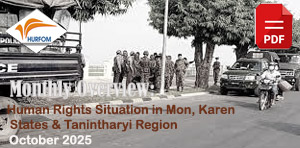A road runs through it: Accounts of abuse during strand road construction in Thanbyuzayat
June 26, 2009
INTRODUCTION
Along the coast of western Thanbyuzayat Township lies one of Burma’s most beautiful beaches. Besides the natural beauty of the coastline, the region is home to hundreds of farmers who are the heart of the local economy, cultivating long-term crops of rubber and fruit trees. However the strand road construction project, begun in January 2009, has been devastating to the structure of the local economy, costing local villagers an estimated 15 billion kyat (US$15 million) in damage to farms, and the project has precipitated hundreds of human rights abuses.![]() Download report as PDF [ 1.61MB]
Download report as PDF [ 1.61MB]
The new road, about 75% completed at the writing of this report, is expected to span 11 miles in total, said local sources. But according to the state run newspaper, Myanmar Alin, the strand road will to be 14 miles (22.5 kilometers) long, and will connect the popular tourist destinations of Setse beach and Kyaikami Sub-town.1 At this time, HURFOM has been able to confirm 13 miles for the road’s proposed length. According to the State Peace and Development Council (SPDC) junta, and the Thanbyuzayat Township Peace and Development Council (TPDC)2, the local residents will save time traveling between Kyaikami Sub-town and the famous Setse beach and visitors will be able to view the natural beauty of the western coast of Mon State by traveling along this new strand road. Despite this project developing in a relatively small area, the construction of the road has already brought a disproportionately high rate of human rights abuses to the region’s farmers and village communities, caught in the middle of the SPDC’s attempts to use the region’s costal beauty to attract tourism.
______________________________________________________________
1 ‘Mynmar Alin’ (The New Light of Mynmar), January 30th, 2009.
2 The strand road project was ordered directly by Lt-Gen Tha Aye, the Chief of Bureau of Special Operations 4 (for Karen State, Mon State and Tenasserim Division), and Brig-Gen Thet Naing Win, Southeast Command, Chairman of Mon State Peace and Development Council (PDC), according to reliable sources from the Thanbyuzayat TPDC. A source close to the Department of Township Construction, Chairman of TPDC, Township managers and head of civil engineers were ordered to report the monthly progress of building this new strand road to Brig-Gen Thet Naing Win, Southeast Commander and Chairman of Mon State PDC.
_____________________________________________________________
 This report will focus on the most commonly occurring abuses against villagers and farmers, and examine their immediate and long-term regional impacts. The first section begins with a brief background concerning the already weakened economy in Thanbyuzayat Township. The second is broken down into the three most common human rights abuses of: land seizure, forced security and manual labor, and the forced support of SPDC construction workers. Each section includes individuals’ accounts of abuse, compiled by HURFOM field reporters, and analyses of the abuses’ impacts. The last section concludes the report with further analysis of the strand road project and addresses the possibility of broader, longer-term effects of the government’s attempts to capitalize on the region’s natural beauty.
This report will focus on the most commonly occurring abuses against villagers and farmers, and examine their immediate and long-term regional impacts. The first section begins with a brief background concerning the already weakened economy in Thanbyuzayat Township. The second is broken down into the three most common human rights abuses of: land seizure, forced security and manual labor, and the forced support of SPDC construction workers. Each section includes individuals’ accounts of abuse, compiled by HURFOM field reporters, and analyses of the abuses’ impacts. The last section concludes the report with further analysis of the strand road project and addresses the possibility of broader, longer-term effects of the government’s attempts to capitalize on the region’s natural beauty.
BACKGROUND
Thanbyuzayat Township is one of the major farming regions in Mon state, growing long-term fruit tree crops, and the cash crop of Mon state, rubber. Last year, as the United States economic crisis unfolded, reverberations could be felt throughout the rubber industry in Mon state. Plantation owners were hit particularly hard, with rubber prices dropping from last  year’s average price of 1,400 kyat per pound, to a precipitous 350 kyat per pound in some places. In the 1st week of June, according to estimates from local villagers in Thanbyuzayat, the estimated price of rubber was 680 kyat per pound. The disastrous economic impacts of this price drop have undercut the farmers’ ability to turn any profit. Fruit farmers are also suffering as the overall collapse of the regional economy has driven away their regular buyers3. As a result, farmers in Thanbyuzayat have begun taking out loans with very high monthly interest rates (upwards of 10%), hedging their bets on next year’s crop again bringing them a profit. According to field reporter estimates, 80% of the population in Thanbyuzayat is suffering directly from the economic crisis. Within this 80% figure, the majority of families with disposable incomes have children working aboard in Thailand, Malaysia, or Singapore. Without any outside source of income, families fall into debt and are struggling to survive.
year’s average price of 1,400 kyat per pound, to a precipitous 350 kyat per pound in some places. In the 1st week of June, according to estimates from local villagers in Thanbyuzayat, the estimated price of rubber was 680 kyat per pound. The disastrous economic impacts of this price drop have undercut the farmers’ ability to turn any profit. Fruit farmers are also suffering as the overall collapse of the regional economy has driven away their regular buyers3. As a result, farmers in Thanbyuzayat have begun taking out loans with very high monthly interest rates (upwards of 10%), hedging their bets on next year’s crop again bringing them a profit. According to field reporter estimates, 80% of the population in Thanbyuzayat is suffering directly from the economic crisis. Within this 80% figure, the majority of families with disposable incomes have children working aboard in Thailand, Malaysia, or Singapore. Without any outside source of income, families fall into debt and are struggling to survive.
It is in this climate that the strand road project progresses, violating the rights of farmers whose livelihoods are already stretched to the breaking point. For farmers who had hoped to recover economically next year, the uncompensated seizure of land undercuts this possibility. Forced labor and guarding takes farmers away from their crops, and sometimes they are even asked to help destroy their own lands. Lastly, the forced acquisition of supplies for the SPDC construction workers from farmers drains the farmers’ own subsistence resources, and exacts what little money they have available to provide for the very people ordering and overseeing the destruction of their lands.
Three HURFOM reporters and their contacts have been the primary sources of information regarding abuses along the strand road. They have closely monitored the abuses against farmers and plantation owners and other related violations committed by the members of the TPDC, Department of Township Construction and the Department of Township Land Record due to the construction of the strand road.
The reporters secretly met with about 48 landowners through the help of their local contacts and focused their documentation on three types of abuses related to this new road construction. Some sources of information in this report are not the victims, but the residents who live in the villages close to the construction sites, and who are able to narrate what they saw during the TPDC construction of the road. Due to increased SPDC security in the region over the construction project, and the subsequent threat to HURFOM field reporters, the following accounts of abuse are just a sampling of wider abuses practiced all along the strand road project.
_______________________________________________________
3 Independent Mon News Agency (IMNA) ‘Rubber prices continue to plummet; workers face dire economic circumstances as others feel the knock-on effects’ Thu 18 Dec 2008, Asah, IMNA Lt-Gen Tha Aye, the Chief of Bureau Special Operations 4, is seen inspecting Setse beach and the new road project. [photo: The New Light of Myanmar]
______________________________________________________________
LAND SEIZURE
The seizure of land between Setse Beach and Kyaikami Sub-town has been the primary abuse perpetrated against villagers during the strand road project. Foremost, this abuse destroys the livelihoods of farmers who have already suffered from the weak rubber economy. Seizure of land not only undermines the possibility of a profitable harvest next season, but without compensation, drains millions of kyat from a local economy that cannot support further negative economic pressure. There has been no effort on the part of the TPDC to provide compensation to villagers whose land has been seized, and whose rubber trees have been destroyed. HURFOM has gathered different estimates of how extensive the damage has been, in terms of the total number of trees destroyed thus far during road construction. Three estimates have been included in this report, as the exact number of destroyed trees is impossible to ascertain, given the scope of damage, and limited access due to TPDC security.
The highest estimate comes from a low-level staff member from the agricultural department, who estimated 220,000 rubber trees have been destroyed. According to a local schoolteacher from Setse Beach, an estimated 100,000 trees have been destroyed. Also, a 35-year-old villager from Sintaung estimates the damage to be somewhere between 120,000 to 150,000 rubber trees destroyed. These numbers, though estimates, originate from well-informed sources close to the strand road project. These estimates represent just a portion of the total damage; according to two sources in Setse and Thanbyuzayat, is an estimated 75% complete.
In the case of Ko Aye Myint, a 40-year-old farmer from Anansan Village, Thanbyuzayat Township, he and his family attempted to avoid the staggering losses of land seizure by selling their farm in advance, but were unable to. Their survival is only possible with additional economic support from another family business:
In our farm, about 50 rubber trees were destroyed by the construction of the Setse and Kyaikami road. We had been hearing about the road construction for two years but we didn’t think it would happen. Last year, the land surveyor came and surveyed our land. We figured that the project would be happening soon. At that time, we tried to sell our farm. However, rubber prices fell and we couldn’t sell our farm. We spent about 400,000 kyat including fertilizer and renting the workers to develop our farm, which is 8 acres wide, to improve it for this year.
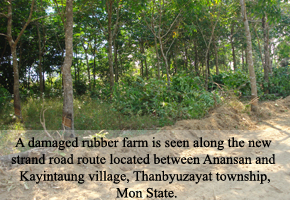 Now we are depressed by the farming. Because we can’t find other jobs and don’t have the resources to create new jobs, we continue to tend to the rest of our plantation. Our family has survived with a small shop run by my wife in Thanbyuzayat Township. Since the local authority logged our farm, I don’t want to farm anymore. Now, we face difficulties on our farm because of the logging, and it is difficult to sell our farm. Honestly, we want to get the compensations from the government, but we dare not ask them. Don’t say we will get the compensations; they also will take the trees they already logged for use in their projects.
Now we are depressed by the farming. Because we can’t find other jobs and don’t have the resources to create new jobs, we continue to tend to the rest of our plantation. Our family has survived with a small shop run by my wife in Thanbyuzayat Township. Since the local authority logged our farm, I don’t want to farm anymore. Now, we face difficulties on our farm because of the logging, and it is difficult to sell our farm. Honestly, we want to get the compensations from the government, but we dare not ask them. Don’t say we will get the compensations; they also will take the trees they already logged for use in their projects.
Daw Nyaut San, a 28-year-old farmer, from Yathaetaung, has since relocated to Setse, Thanbyuzayat Township:
Because the rubber price fell last year, the farm owners had faced problems for their plantations. In addition, this year they also faced the new road construction destroying their plantations. They felt disappointed and saddened by the new road construction.
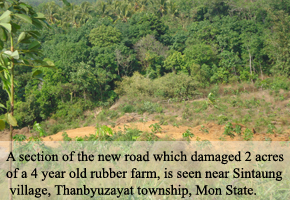 Most of our relatives have survived from rubber plantations for many years. Now they are very sad for their plantations have been destroyed; they lost about 800 rubber trees for the new road construction. They see that the new road construction is better for the government economy but destroys the economy in the local areas.
Most of our relatives have survived from rubber plantations for many years. Now they are very sad for their plantations have been destroyed; they lost about 800 rubber trees for the new road construction. They see that the new road construction is better for the government economy but destroys the economy in the local areas.
With the local economy already in crisis after last year’s drop in rubber price, the land seizures from the strand road construction destroy any possibility of economic recovery for the victims. The road, which is built by the government to improve income from the tourist economy, does nothing to support or invigorate the local economy, leaving many impoverished farmers with no option but to move away. Moreover, farmers are migrating because they have no confidence in reinvesting in the remaining farms. Despite attempts by farmers to sell their farms, no one will buy the property for fear the government will seize more land. Many farmers relocate to Thailand as migrant workers, and their children have no option of reinvesting or continuing cultivation of the family farm.
Ma May Oo, who is 35-years-old, and a former government employee from Kyaikami, Thanbyuzayat Township, has witnessed numerous cases of land seizure in which villagers remain uncompensated:
The government had planned to implement this new road project over two years ago. They met with the land-surveying officer, engineer, and TPDC municipal department to implement the Setse and Kyaikami road project. At that time, I figured that if they would implement the road project, the people would have lost their land and plantations. Especially we should consider the main economy of the local villager. In these areas, they mainly plant betel nut, rubber, rambutan, and pomelo. Now we heard that many people have lost [their own land], especially the rubber and coconut plantations in the area. One of my friends said that their parents’ farm also had lost 80 rubber trees in the road project. In addition, their neighbor’s farm also had been logged by the new road project. Even though we don’t have exact numbers of the damage around the neighbor areas, we can estimate over 300 rubber plants had to be destroyed near their farm.
The government always confiscated residents’ land without compensation for the development projects. I have never seen people who lost their property and land get compensation in the development projects when I worked in the government office. Rubber prices went down, rubber farm owners [already] faced difficulties last year. Some people have lost their rubber plantations because of the government development project; some lost their investments last year and lost their investments this year.
Some people left their farms and found other jobs in neighboring countries and trading at the [Thai-Burma] border, such as in Myawaddy, to help the family income. The land between the Setse and Kyaikami belong to their grandparents; therefore, the people are very sad to lose their farm. I am very sad for the people who lost their rubber plantation. They [people who lost their plantation] felt very sad for their plantation. From my perspective, the government should compensate the farm owners who have lost their rubber plants for the new road project.
Ko Aye Thein, a 35-year-old farmer from Kayintaung, Thanbyuzayat Township, took out a loan after not making any money on last year’s rubber harvest, to try to continue cultivating his rubber plantation in hopes of turning a profit this coming year. However, the seizure of his farmland has destroyed any hope of a profitable harvest:
We had invested in our rubber plantation with loaned money from the neighborhood. We cannot pay back the money that we borrowed from our neighborhood yet. We spent about 12 million kyat to develop our farm last year. Because of the [government] development project, as for me, I am very disappointed and sad about our rubber plantation. Last year also we didn’t get any profits from our farm because the rubber price was low in the market. We tried to prepare our farm for this year and we spent all our money to develop [it]. We did a lot of work but no results came from our farm. I felt very sorry for losing our farm. That is why, I want to suggest to the authority to give compensations to the people who lost their land and rubber plantations for the new road construction.
Even though the government implemented the project, the project will not benefit the local people. Because of the new road construction, the people who depended on the economy of the rubber plantations have difficulties for their survival and income. The government should think about the people who lost their rubber plantation and compensate them.”
FORCED SECURITY AND MANUAL LABOR
Another common abuse is the forced provision of manual labor and security. The TPDC’s campaign has inarguably upset farmers and plantation owners in the region who have been forced to give up their land without compensation. The construction team consists of 4 to 5 truck and bulldozer drivers, and approximately 20 more people clearing and preparing land. Though there are no insurgent groups in the area, the TPDC is concerned that victims disgruntled over their loss of property will assault the construction crews. According to a rumor from several sources, farmers killed one bulldozer driver near the Kayin Taung village during construction in a farm. The TPDC hopes to buffer itself from violent blowback by holding the village headmen responsible for informing farmers when the bulldozers will come and clear their farm, and also arranging villagers into groups to provide security for the construction workers. Likewise villagers are held responsible for the security for the construction team they are assigned to guard. Unarmed, each owner must guard the construction workers working on his or her property, as well as that of the neighboring farms. Each farmer spends approximately 3 to 5 days standing guard for the construction workers.
Nai Toe, who is 35-years-old and from Anansan village, was one of the villagers forced to stand guard for construction workers while his own farm was being destroyed:
The government started implementing the road project in early January with the land surveyor, bulldozer driver, engineers and other construction workers. The village headman called the people whose farms were being included into the road project to take responsibility for the security when the authorities were to come and clear the farms. Not only had they lost their farms but also were forced to provide security for the construction workers. The command came from the higher level officers, and the village headman, and other villagers had to follow their orders.
Mg Nyunt Shwe, a 28-year-old villager from Anansan, describes his family’s loss, having to stand guard while the farm is destroyed, and being forced to perform manual labor:
The people whose farms were included in the road project had to provide security for the construction workers as the project passed through their farms in Anansan, Sin Taung, Yathea Taung, Kayin Taung and Setse village.
They both destroyed and confiscated our plantation for the government project. In addition, we also had to provide security for the construction workers. My father went to be security as they cleared our farm. At that time I noticed that he felt very sad for his farm that was being destroyed. Our village headman said in the meeting that we also have to provide labor in the bridge projects, but I don’t know when we need to go there.
In addition to the security detail, villagers are also forced provide manual labor to build bridges. Some of the bridges are built out of the fallen rubber trees, while others are constructed out of cement. Farmers receive no compensation, and face risks to their safety while working these construction jobs. According to local sources and the government newspaper, the New Light of Myanmar, the strand road will contain 13 bridges.
Ko San, who is a 35-year-old rubber plantation worker who lives near Sin Taung, was forced to work on a new wooden bridge located on the strand road near his home:
Our village headmen organized these unpaid jobs. We had to carry rubber trees to the ten wheels trucks to use in the wooden bridge construction. We had to bring our own food and water. And it took us three days to finish our duty. The work was rotated, and another group of villagers was forced to work after we left.
Ang Nai, A villager from Yathea Taung, described the pain of watching his farm be destroyed, and argues the road does more damage then good economically:
The authorities forced us to watch when they cleared our plantation. I felt very sorry for my rubber trees. We needed to provide the security and followed the construction workers wherever they went in the areas. The commands came from the Township Peace and Development Council [TPDC] in early January. Even though we didn’t want to follow the commands from the TPDC, we couldn’t complain to them. Some people just see the new road projects as effective for trading; however, they don’t consider the people who lose their land and their property. Some people may not know about that. Therefore, we need to describe every single person to show we faced difficulties after the road projects destroyed our farm.
FORCED PROVISION OF FOOD
Not only have local residents lost their land from the strand road construction but they have also been forced to provide food for the construction workers during the project. Forcing villagers to give up their own food and money to feed TPDC construction workers is a form of property destruction. This abuse is particularly damaging for farmers and villagers who have been hard hit by the economic collapse. For many impoverished farmers, the high cost of supplying food and providing work detail cuts into the little money they may have remaining. Such costs eliminate farmers’ reinvestment funds and therefore drain the region of its ability to recover economically.
Nai Jit, a 52-year-old resident of Anansan village, Thanbyuzayat Township, lost trees and provided food to construction workers:
Nearly one acre of my [rubber] trees have been destroyed by the construction of a road section that passed through my plantation. On top of that, I was also forced to bring cooked foods and water for them [construction workers] to eat. And I also have to take sentry duty along with some of my neighbors.
Mg Zay Ya, who is 23-years-old and from Thanbyuzayat, but frequently travels to the area, had to help his family stand guard, as well as pay for and prepare meals for construction workers over a 5-day period:
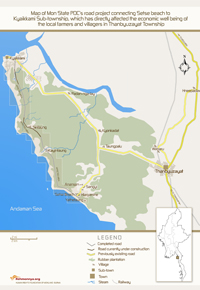 Our family also had to pay for the construction workers’ food when the project came onto our farm. The road project crosses the middle part of our farm. Now our farm is separated into two parts. Our farm was 5 acres wide but now it is only 4 acres [2 acres on each side of the highway]. One acre was destroyed by the government development project. My father and brother had to protect them for 5 days when the road construction workers came to clear our farm. During that time, we also had to cook food for them.
Our family also had to pay for the construction workers’ food when the project came onto our farm. The road project crosses the middle part of our farm. Now our farm is separated into two parts. Our farm was 5 acres wide but now it is only 4 acres [2 acres on each side of the highway]. One acre was destroyed by the government development project. My father and brother had to protect them for 5 days when the road construction workers came to clear our farm. During that time, we also had to cook food for them.
Nai Win, a Yathea Taung villager, narrated his experience being forced to provide food for construction workers, and his subsequent response to the destruction of some of his rubber trees:
The higher-ranking officers forced village headman to command the villager to provide food for the construction workers including engineers, bulldozer drivers, land surveyors and others.
We were both forced to provide security and food to the construction workers, for example rice, salt, cooking oils and other vegetables. Commanded by the village headman, our family had to give 3 chickens, 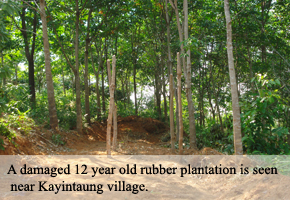 vegetables and other ingredients for 3 days to the construction workers. We had to pay over 40,000 kyat for the construction workers’ food in the government project. We also had to pay for their [the construction workers] food supplies in the project. I am very disappointed. Now that my farm has been cleared by the road project, I don’t want to work there anymore. I felt very sad for my farm as the road project logged over 80 rubber trees. I can’t imagine what I would have done if my farm had lost over 100 trees, as it was with my neighbor’s farm. We did not authorize the government’s implementation of the new road project. They should understand about the local economy and compensate the people who lost their farms. The military government does not listen to their people anymore.
vegetables and other ingredients for 3 days to the construction workers. We had to pay over 40,000 kyat for the construction workers’ food in the government project. We also had to pay for their [the construction workers] food supplies in the project. I am very disappointed. Now that my farm has been cleared by the road project, I don’t want to work there anymore. I felt very sad for my farm as the road project logged over 80 rubber trees. I can’t imagine what I would have done if my farm had lost over 100 trees, as it was with my neighbor’s farm. We did not authorize the government’s implementation of the new road project. They should understand about the local economy and compensate the people who lost their farms. The military government does not listen to their people anymore.
CONCLUSION AND IMPLICATIONS
The strand road construction project has undermined the region’s economic recovery through numerous instances of human rights abuse. Having spent 10 to 20 years cultivating farms and plantations, farmers have expected their investments to pay off with a profitable crop yield. But in the span of 10 days, construction teams from the strand road project made those hopes and goals go up in smoke.
As the strand road project nears its completion, HURFOM has learned that a troubling expansion will begin in a matter of months. On June 24th, a day before this report was to be released, field reporters in Wagaru confirmed a TPDC announcement that the land west of the new strand road would be cleared by construction crews to provide a more scenic view of what the government newspaper, Myanmar Alin, describes as “[a] view [of] the natural beauty of the sea.”4. The average distance from the road to the coast is approximately 1 mile, and as the road will extend for at least 13 miles, even a rough estimate represents 13 miles of cleared land—an amount of damage which could dwarf both the scope of extant damage and the human rights abuses documented in this report.
By clearing the western side of the road to facilitate a scenic drive, innumerable families will be forced to leave the region, their land valueless in the face of TPDC seizures. Those who stay will be prevented from rebuilding or replanting, and instead must find a new means of survival within the meager uncertainties of the TPDC’s new tourist economy. While this report can only cover the scope of the strand road project, the proposed clearing of the western side of the road will require additional exploration and continued documentation.
Daw Aye, a 48-year-old Anansan resident, from Thanbyuzayat Township explained, “I worry very much because they [the construction workers] said they will make this road look beautiful and show its natural beauty. It means they will clean out all the trees from between the beach and this new strand road. These plantations are our future and our life. Without their business, my family cannot survive anymore.”
__________________________________________________________
4 ‘Myanmar Alin’ (The New Light Myanmar) January, 30th 2009
Comments
Got something to say?
You must be logged in to post a comment.




